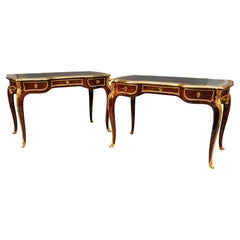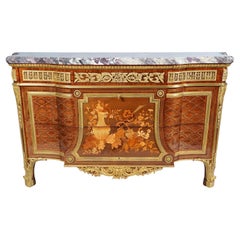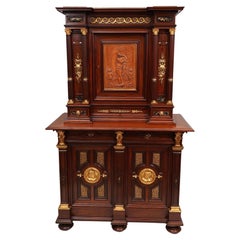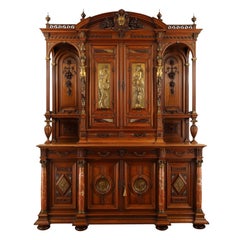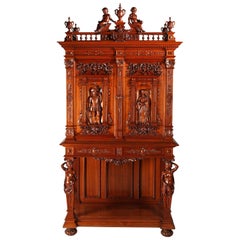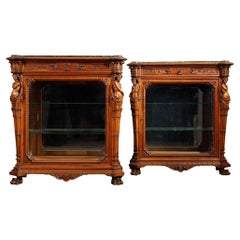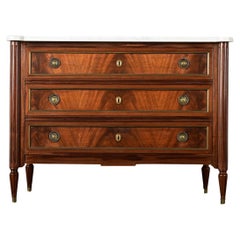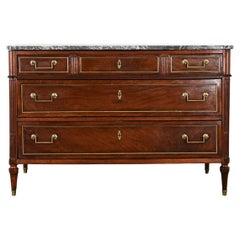Tobogan Antiques Case Pieces and Storage Cabinets
to
6
Height
to
Width
to
Depth
to
23
23
3
3
23
23
14
14
10
10
23
23
23
23
23
2
1
1
1
1
H.-L. Wassmus, Pair of Desks, France, circa 1860
Located in PARIS, FR
Desk 1 – Height : 73,5 cm (28,9 in.) ; Length : 118,5 cm (46,6 in.) ; Depth: 64 cm (25,2 in.)
Desk 2 – Height : 73,5 cm (28,9 in.) ; Length : 118 cm (46,4 in.) ; Depth : 64,7 cm (25,...
Category
Antique 1860s French Napoleon III Desks
Materials
Bronze
$41,666 / item
Important Louis XVI Style Commode by F. Linke, France, circa 1890
By François Linke
Located in PARIS, FR
Signed F. Linke
Important Louis XVI style commode with a central domed projection, in amaranth and satin veneer, with concave sides, and richly decorated with chiseled and gilded br...
Category
Antique 1890s French Louis XVI Commodes and Chests of Drawers
Materials
Marble, Bronze
Neo-Renaissance Cabinet by P. Sormani and attr. to E. Lièvre, France, Circa 1870
By Paul Sormani, Edouard Lievre
Located in PARIS, FR
Signed twice on the lock P. SORMANI 10 rue Charlot Paris
Rare neo-Renaissance cabinet in carved wood and Portor marble, adorned with chiseled and gilded bronze.
The upper, part, surmounted by a frieze of posts and marble cabochons, consists of a central door decorated with a carved panel representing the birth of Venus, framed by two pairs of ringed and fluted columns with Corinthians capitals in gilded bronze revealing two doors with secret opening. Two drawers with lion’s head shaped handles and a central drawer decorated with tracery in gilded bronze complete the upper part of this cabinet.
In the lower part, two drawers on the belt with diamond...
Category
Antique 1870s French Renaissance Cabinets
Materials
Marble, Bronze
$64,761 Sale Price
38% Off
Neo-Renaissance Dining Room Set Att. to Barbedienne, Meynard & Sevin, circa 1890
By Louis-Constant Sevin, Ferdinand Barbedienne
Located in PARIS, FR
Display sideboard : height : 285 cm (112 in.) ; width : 215 cm (84,6 in) ; depth : 70 cm (27,5 in.)
Table (without extension) : height : 76 cm (29,9 in.) ; width : 170 cm (66,9 in.) ; depth : 120 cm (47,2 in.) / Extensions (x 2) : width : 45 cm (17,7 in.) ; depth : 120 cm (47,2 in.)
Dresser : height : 180 cm (70,8 in.) ; width : 215 cm (84,6 in.) ; Depth : 65 cm (25,6 in.)
Chairs : height : 114 cm (44,8 in.) ; width : 48 cm (18,9 in.) ; depth : 45 cm (17,7 in.)
Woodwork attributed to Maison Meynard (1808-1889), Meynard Fils; ormolu mounting by Ferdinand Barbedienne (1810-1892) from drawing by Louis-Constant Sévin...
Category
Antique 1870s French Renaissance Revival Dressers
Materials
Marble, Bronze
Renaissance Style Wooden Cabinet Attributed to H.A. Fourdinois, France, 1893
Located in PARIS, FR
A wooden cupboard, elaborately carved throughout, dated "1893" on the crest and attributed to H.A. Fourdinois. The upper section with a pair of cherubs at the center of a balustrade ornamented with two-handled urns, two architectonic doors below, carved with lady and gentleman in niches surrounded by extensive carving with classical motifs. The lower section with two drawers above a standing female caryatid support at each front corner. The all reposing on four gadronned round feet.
The Fourdinois company was founded in 1835 by Alexandre-Georges Fourdinois (1799-1871). The Universal Exhibition held in London in 1851 was undoubtedly their first great artistic and public success. Winning the Great medal for a neo-Renaissance buffet...
Category
Antique 1890s French Renaissance Cabinets
Materials
Wood
$15,714 Sale Price
40% Off
Pair of Neo-Renaissance Vitrines, Attributed to H-A Fourdinois, France, c. 1860
Located in PARIS, FR
Fine pair of neo-Renaissance vitrines in richly carved wood, with three glazed sides framed by a relief frieze. Each opening to a drawer decorated with interlacing on the belt, and t...
Category
Antique 1860s French Renaissance Revival Vitrines
Materials
Marble
Pair of Louis XVI Style Commodes Attributed to Krieger, France, Circa 1880
By Antoine Krieger
Located in PARIS, FR
Pair of Louis XVI style commodes attributed to Krieger, in veneered wood and gilded bronze ; opening with three drawers, including one on the belt forming a writing desk and concealing two small side drawers. The commodes are decorated with an interlacing marquetry set with a double net on a green tinted wood background decorated in its center with florets. Rich ornamentation of chiseled and gilded bronzes decorated with acanthus friezes on the belt and garlands of flowers and frieze of posts at the corners, molded frames of water leaves on the side panels.
They rest on four fluted feet surmounted by Corinthian capitals, and with a Griotte marble top.
These commodes are inspired by those created by Jean-François Leleu delivered by order n° 32 of May 1st, 1773, with a third commode kept in London (Wallace Collection) for the bedroom of the Princesse de Condé at the Palais Bourbon in Paris. The central diamond, originally inlaid with a lily flower pattern, was changed during the Revolution. The pair is now exposed in the Petit Trianon in Versailles (see photo n°1 attached).
Jean-François Leleu (1729-1807), Parisian cabinet-maker, began his career as an apprentice in Jean-François Oeben’s workshop. Installed on the chaussée de la Contrescarpe, he became Maître ébéniste in 1764 and moved to rue Royale-Saint-Antoine. He worked for an aristocratic private clientele, including the prince de Condé for whom he delivered furniture between 1772 and 1777, or the comtesse du Barry...
Category
Antique 1880s French Louis XVI Commodes and Chests of Drawers
Materials
Marble, Bronze
Renaissance Style "Four Seasons" Cabinet by M. Lerolle, France, Circa 1890
By Lerolle
Located in PARIS, FR
Signed " Meubles D’Art, M. Lerolle, Fabricant, 61, Rue des Sts-Peres. Paris "
Remarkable carved wood cabinet, richly sculpted in the Neo-Renaissance style, and inlaid with vert de m...
Category
Antique 1890s French Renaissance Revival Cabinets
Materials
Marble
Pair of Louis XV Style Vitrines Attributed to J.-E. Zwiener, France, Circa 1885
By Joseph-Emmanuel Zwiener
Located in PARIS, FR
Rare pair of Louis XV style gilt-bronze mounted curved shape vitrines attributed to J.E Zwiener. Glazed on all sides, they open with two doors framed by gilded and chiseled Rocaille style foliated bronze mounts. Resting on four cabriole legs ending with lion’s paws, the whole is covered by a « brèche de Benou » marble top. This model was probably designed by L. Messagé.
Joseph-Emmanuel Zwiener was born in Germany in 1849. In 1880 he sets up his extensive workshops in rue de la Roquette in Paris where he creates many original pieces of furniture. He imitated practically every style, ranging from ‘’Boulle’’ to Louis XVI and including extraordinary personal interpretations of the Louis XV ‘’exuberant’’ style. He participated in the 1889 Universal Exhibition, held in Paris, and was awarded the gold medal for his remarkable copy of that most famous piece of furniture, Louis XV’s desk. The catalogue of the exhibition included a wonderful elegy qualifying the work as perfect : « No criticism what-so-ever could be made ». As that other famous cabinet-maker François Linke, Zwiener had most of his bronzes modelled by Léon Messagé whose work was considered as being of the best possible quality.
Léon Messagé is a renowned designer and sculptor who integrated in his ornaments related to the Rocaille asymmetry, new lines and shapes announcing the “Art Nouveau” style. But even though, Messagé found inspiration with these 18th century artists, such as Nicolas Pineau or J. A. Meissonier, he didn’t simply copy their work and showed great originality, even extravagance, with some designs contained in "Cahier des dessins et croquis style Louis XV". He realized numerous sketches on grey paper before the execution of a reduced or life sized model of his ornaments, made of wax or terra-cotta. From 1885, Léon Messagé started working with important Parisian cabinet...
Category
Antique 1880s French Louis XV Vitrines
Materials
Marble, Bronze
$61,904 Sale Price / set
20% Off
Exceptional L XVI Style Regulator-Wardrobe by Maison Forest, France, Circa 1890
By Forest A' Paris
Located in PARIS, FR
Signed Forest à Paris
A rare Louis XIV style wardrobe with a break-fronted ogee pediment. Opening with two side cupboards flanking a regulator clock, richly decorated with marquet...
Category
Antique 1890s French Louis XIV Wardrobes and Armoires
Materials
Bronze
Louis XV Style Lacquered Wood Flat Desk by A.E. Beurdeley, France, Circa 1890
By Alfred Emmanuel Louis Beurdeley
Located in PARIS, FR
Stamped twice A Beurdeley a Paris on the crosspieces.
Elegant Louis XV style double-side desk in lacquered wood and gilded bronze. It is adorned on all sides, in foliated bronze car...
Category
Antique 1890s French Louis XV Desks
Materials
Bronze
$104,166 Sale Price
30% Off
Wooden & Enameled Display Sideboard Attributed to H.A Fourdinois, France, c1867
Located in PARIS, FR
Important two-tiered sideboard attributed to H.A. Fourdinois made in natural and carved wood : the lower part made up of four panels, two concave ones and two doors, richly ornated with a polychrome enameled floral decoration and gilt bronze plaques.
A large dual drawer is surmounted by the upper part of the sideboard, opening with two glazed doors, framed by detached columns. The entire unit is topped with a pediment onto which a female bust is carved in relief within a medallion on a gilt background.
With a matching set of twelve chairs.
The Forney library in Paris preserves order registers of the Fourdinois as well as sketches books and pictures representing pieces of furniture made by the Fourdinois workshops. In this documentation, some elements enable us to link this sideboard with Henri-Auguste Fourdinois’ productions, such as the large scrolls linking the upper part to the lower part of the sideboard, as well as the detached columns carved at their lower third. (picture n°1 attached)
Notebook containing ink-sketches coming from the Fourdinois workshop shows a project for a pelmet, beautified with a centering trophy composed of a torch and a quiver within in a foliage wreath, this motif obviously reused by the Fourdinois on the central decoration of the panels of our sideboard. (picture n°2 attached)
The firm of Fourdinois, considered during the Second Empire as the greatest furniture manufacturer in Paris, was founded in 1835 by Alexandre-Georges Fourdinois (1799-1871). It was developped in the context of the Expositions Universelles. At the time, the firm already produces furniture of the Neo-Renaissance style, such as a dresser that won the Great Medal at the London Universal Exhibition of 1851. The son, Henri-Auguste Fourdinois (1830-1907), joined the firm in 1860 and will become head of the firm in 1867. The high quality of his designs was remarked at the Universal Exhibition in 1862, when the jury awarded him two medals « for Excellence of Composition and Execution ». Henri-Auguste, now sole in charge, brought the firm to the summit of its achievements at the 1867 Universal Exhibition in Paris by winning the Grand Prize for his stand. Apart from the commissions he executed for the « Mobilier de la Couronne », he also produced high quality furniture for the Parisian bourgeoisie. The firm is at its zenith during the years 1862-1880. At this time, it is considered as an example to follow for other cabinet-makers, whether they are French, British or American.
Through the quality of execution and the extreme care taken in the decoration of furniture, H.-A. Fourdinois was particularly appreciated by Napoleon III and Eugenie...
Category
Antique 1860s French Renaissance Sideboards
Materials
Enamel, Bronze
Pair of Lacquered Wood Encoignures, by A.E. Beurdeley, France, Circa 1890
By Alfred Emmanuel Louis Beurdeley
Located in PARIS, FR
Stamped twice A BEURDELEY A PARIS on the back.
Charming Louis XV-inspired pair of encoignures in lacquer and gilded bronze. The animated facade ope...
Category
Antique 1890s French Louis XV Corner Cupboards
Materials
Marble, Bronze
Regence Style Wooden Display-Cabinet by C. Potheau, France, circa 1895
By Potheau
Located in PARIS, FR
Signed Constantin Potheau, ébéniste, Paris.
Measures: Height 275 cm (108,2 in., width 160 cm (63 in.);
Upper part depth 48 cm (18.8 in.) / inside 42 cm (16.5 in.)
Lower part dept...
Category
Antique 1890s French Régence Buffets
Materials
Wood
"Japonisme" Vitrine Attributed to A. Giroux, France, Circa 1880
By Maison Giroux
Located in PARIS, FR
Rare aesthetic movement showcase, opening in its upper part by two beveled glass doors framed by brass moldings, in its lower part by two door panels in carved walnut decorated with blooming branches and gilded bronze ornaments representing dragons and birds. The sides are carved, like wicker woven.
This showcase is topped by an important carved and gilded walnut cornice depicting a Fô Dog in its center, with a protective power, and rests on elephant head with overtuned trunk shaped feet.
This type of elephant head with overtuned trunk shaped feet is a characteristic of the Maison Giroux, which can be found on many objects they produced. Aesthetic movement cabinet, signed Maison Alphonse Giroux...
Category
Antique 1880s French Japonisme Vitrines
Materials
Bronze
"Japonisme" Cylinder Desk Att. to G. Viardot, France, circa 1880
By Gabriel Viardot
Located in PARIS, FR
Rare Japanese style cylinder desk in tinted and carved wood, richly engraved on all sides with foliage, cherry branches and geometric interlacing. Surmounted by two asymmetrical shelves, the cylinder is decorated with an engraved dragon. Opening this cylinder reveals many compartments with adjustable dimensions, a drawer with engraved decoration and letter storage. The cylinder sides can open laterally, allowing a larger area for working and writing.
The lower part of the desk is formed on the left by five superimposed drawers decorated with geometric interlacing and carved branches, as well as Japanese characters, deer and mother-of-pearl foliage. On the right, there is a drawer and a door decorated with carved leaves and mother-of-pearl interlacing, revealing four drawers forming compartments.
An ingenious mechanism makes it possible, when the cylinder is closed with a key, to completely lock the desk.
Gabriel Viardot career began as a wood carver and he produced small furniture, sculpturally carved with naturalistic motifs and animals. In the 1855 Exposition Universelle in Paris, his finely sculpted objects were well received. However, with the increasing importation of similarly produced Swiss and German articles, he found less opportunity for these and decided to innovate. G. Viardot succeeded to his father’s business in 1861 installed rue Rambuteau in Paris. Around 1870 he turned to the idea of producing « Meubles genre Chinois et Japonais ». The taste in Europe for exotic furniture, incorporating sometimes authentic Chinese or Japanese objects...
Category
Antique 1880s French Japonisme Desks
Materials
Mother-of-Pearl, Wood
Exceptionel Bookcase Forming Desk, by G. Grohé, France, Circa 1860
By Guillaume Grohe
Located in PARIS, FR
Exceptional neo Renaissance bookcase forming desk. This monumental piece consists in a lower part forming drop-front desk supported by two pillars with drawers. The lateral parts each open with a moulded door. The bookcase occupies the upper part, opening by four windows...
Category
Antique 1860s French Renaissance Bookcases
Materials
Wood
Japanese Style Cabinet-Secretary Att. to Perret & Vibert, France, circa 1880
By Perret et Vibert
Located in PARIS, FR
A Japanese style carved wood cabinet, with a painted decor imitating Japanese lacquer, ornamented with flowers, birds and butterflies. Opening onto two drawers and a paper filer, the upright-secretary door is also fitted with red velvet. Surmounted by a drawer and asymmetrical shelves, composed in the Japanese « zen » spirit, the cabinet stands on four legs joined by an engraved stretcher.
The great influence of the Far-East, through China and Japan, in the second half of the 19th century French art could be found first in painting and soon after in decorative arts and furniture as well.
Following the Franco-English military campaign led in 1860 against the Imperial army in China, the French troops of Napoleon III brought back from the Summer Palace, a part of the Chinese Imperial court treasure, which will make up the famous Chinese Museum of Empress Eugénie at the Fontainebleau Palace. The French artists won’t be long to take inspiration from those exotic and sumptuous objects for their creations, as they used to do in the 18th century, when the best French cabinet-makers adapted the Chinese lacquers on the luxurious royal chests.
But the influence of Japan, at the Meiji period (1868-1912), came also very quickly to France, thanks to the opening of the country in the middle of the 19th century, as well as the development of traveling and the amazing Universal Exhibitions, in which Japan participated for the first time in 1867 in Paris. Then many Japanese objects and prints were imported to France and to all Europe, and for which some collectors spent already fortunes.
With Manet and Impressionists generation, the passion for Japanese art, more than a simple taste for an exotic style, was still in fashion until the turn of the 19th century. It provoked not only a craze among the French aristocratic families as well as the wealthy Paris high society, wishing renew their mansion inner decoration, but turned also to a real revolutionary movement among the “avant-garde” artists. Those artists, whoever they were, painters, cabinet-makers or designers of ceramic, bronze and crystal objects, adapted then those techniques and naturalistic motifs unknown until this time.
Christofle, very famous since 1867 as a silversmith, was also one of the leaders among the inventors of Japanism. He knew how to use Japanese elements to his own splendid works made in silver or “cloisonné” enameled bronze. During the 1878 Paris Universal Exhibition, Christofle presented with great success his life-sized bronze Japanese ladies torcheres, executed by the renowned sculptor Guillemin.
Another famous company to be mentioned, is “L’Escalier de Cristal”, producing art objects and furniture, all of high standard quality and innovating much with their Japanese decor. Highly remarked during the Universal Exhibitions, “L’Escalier de Cristal” collaborated with the greatest artists, such Gallé and Rousseau for glass- and ceramic wares, and the cabinet-makers Lièvre and Viardot, whom made furniture including sometimes authentic Japanese elements.
In 1872, Alfred Perret and Ernest Vibert opened in Paris, at 33 rue du Quatre-Septembre a store that offered “natural bamboo furniture and cane seats” and all kinds of textile fittings for furniture. This furniture used for winter gardens and terraces of mansions knew then a resounding success. They developed their business around 1884 with their Japanese style furniture, very close to that executed by Gabriel Viardot (1830-1906). In 1886, the company appearing in the category of “Chinoiserie and Japoneries” offered, in addition to furniture and seating creation, works of art and inlaid furniture directly imported from the Far East ; an activity that expanded rapidly. Their exotic fantasy furniture presented at the Universal Exhibition of Paris in 1889 and 1900, rewarded them two silver medals. In 1894, the company was listed under the name “Perret et Vibert”, headed by the son of Alfred Perret and Ernest Vibert. The same year, they redesigned their store on rue du Quatre-Septembre, creating ten new show-rooms, showing complete furniture sets of Japanese and Chinese style inspiration. It was not until 1895, that the company was finally named “La Maison des Bambous” and organized then in their shops an “exhibition of country furniture and seats for castles and villas”, which was visited by Empress Eugenie to furnish her villa Cyrnos at Cap Martin. She actually was a regular customer of the “Maison des Bambous” as she bought repeatedly furniture. In October of the same year, the king of Greece...
Category
Antique 1880s French Japonisme Secretaires
Materials
Wood
Renaissance Style Cabinet, France, Circa 1870
Located in PARIS, FR
An outstanding carved cabinet in the Renaissance style. The upper part consists in two stages with arcades, divided in six compartments by rich columns with Corinthian capitals, and topped by a carved entablature. The lower part opens with three doors, ornated with masks, hybrid figures and foliates, and relies on four strong feet.
This cabinet, probably executed for an amateur or a collector, is a perfect model for the neo-Renaissance style, that rose in the 1830’s, in France with the designers Claude-Aimé Chenavard (1798-1838) and Michel Liénard (1810-1870). It came some years after the Gothic Revival, but met a longer success during the 19th century (at the Expositions des Produits de l’industrie in 1844 and 1849, and at the Universal Exhibitions in 1855, 1867 and 1878). Inspiration was found in the French Renaissance, more specifically in the art of Henri II’s reign, and cabinet-makers used dark carved...
Category
Antique 1870s French Renaissance Cabinets
Materials
Wood
Japanese Style Cabinet-Secretary Attributed to G. Viardot, France, Circa 1880
By Gabriel Viardot
Located in PARIS, FR
A Japanese style carved wood cabinet attributed to G. Viardot. A painted decor imitating Japanese lacquer, ornamented with flowers, birds and butterflies. Opening onto two drawers an...
Category
Antique 1880s French Japonisme Cabinets
Materials
Wood, Paint
Neo-Renaissance Cabinet by G.F. Quignon, Universal Exhibition of Paris 1889
By Frederic Gustave Quignon
Located in PARIS, FR
Presented at the Universal Exhibition of Paris in 1889
Important sculpted and engraved natural wood, patinated bronze and Griotte de Campan red marble inlaid Neo-Renaissance style cabinet.
The upper part is composed of a frieze of bronze medallions separated by triglyphs and supported by ribbed columns with Corinthian capitals. There are eight of these columns paired at the front and two simple columns at the rear. The facade presents an alternation of bronzes in niches and cartouches, of marble slates in cartouches sometimes flanked by palmettes, and of engraved motives of laurel and foliage scrolls. The upper part opens with three leaves and three mobile compartments. The belt carved with acanthus leaves opens with two drawers. This cabinet is supported by four richly sculpted tapered feet ending with claws. Four fluted pilasters are inscribed in the moulded back as counterparts. The whole ensemble stands on a moulded plinth and eight rounded feet.
Neo Renaissance Cabinet...
Category
Antique 1880s French Renaissance Cabinets
Materials
Marble, Bronze
$128,570 Sale Price
20% Off
Exceptional Marquetry Cabinet Attributed to Susse Frères, France, Circa 1880
By Susse Freres
Located in PARIS, FR
Blackened wood side-cabinet attributed to Susse Frères, opening with a central cupboard door underlined with gilt bronze rods, flanked by two small onyx c...
Category
Antique 1880s French Cabinets
Materials
Lapis Lazuli, Onyx, Marble, Brass, Bronze
Louis XVI Style Secretary by H. Dasson, France, Circa 1880
By Henry Dasson
Located in PARIS, FR
A very fine Louis XVI style upright secretary, executed in veneered wood, finely decorated with painted medallions representing mythological scenes. Fine chiseled and gilded bronze m...
Category
Antique 1880s French Louis XVI Secretaires
Materials
Bronze
$64,285 Sale Price
38% Off
Related Items
French 20th Century Louis XVI Style Commode
Located in Baton Rouge, LA
A glorious 20th century vintage reproduction Louis XVI-style commode from France, true to the spirit of an antique original with a marble top on a mahogany & beech wood case of three...
Category
20th Century French Louis XVI Commodes and Chests of Drawers
Materials
Marble, Brass
French Louis XVI Style Mahogany Commode
Located in Baton Rouge, LA
A gorgeous Louis XVI style marble-topped mahogany commode from France, circa 1870, with Neoclassical and transitional details that could suit a wide range of decorating tastes today....
Category
Antique 19th Century French Louis XVI Commodes and Chests of Drawers
Materials
Marble, Brass
Antique Victorian Renaissance Revival Walnut Burl Marble Top Dresser & Mirror
Located in Dayton, OH
A charming antique Victorian Renaissance Revival dresser & mirror, circa 1880s. Made from walnut with vibrant burled panels along the front and matchbook burling along the sides. Fe...
Category
Antique Late 19th Century Renaissance Revival Dressers
Materials
Brass
$2,000 Sale Price
20% Off
H 88.5 in W 43 in D 18.5 in
19th Century Swedish Desk Circa 1860
Located in Atlanta, GA
This classic Swedish desk, crafted from pine wood and dating to the mid-19th century, embodies timeless elegance and functionality. The desk features a beautiful painted finish in a ...
Category
Antique 19th Century Swedish Gustavian Desks
Materials
Pine
Pr. Danish Mid-Century Modern Style Dressers Att. to G Plan
By G Plan Furniture
Located in New York, NY
Stylish architectural pair of Danish style dressers attributed to G - Plan of Great Britain. Both chests are in good original, vintage estate condition, showing only light cosmetic w...
Category
Mid-20th Century English Scandinavian Modern Dressers
Materials
Teak
$2,200 / set
H 31.5 in W 39.5 in D 19.5 in
Louis XV Style Ormolu-Mounted & Marquetry Commode - François Linke Leon Messagé
By François Linke
Located in Los Angeles, CA
A French Louis XV style ormolu-mounted and end-cut floral and fruit marquetry two-drawer serpentine-shaped bombé commode by François Linke (1855-1946), Index number 720, the mounts d...
Category
Early 20th Century French Louis XV Commodes and Chests of Drawers
Materials
Ormolu
$750,000
H 36 in W 71 in D 27 in
Pair of 19th Century Marquetry Italian Wall Vitrines
Located in Houston, TX
Handsome pair of 19th century Italian wall vitrines. Each petite cabinet features beautiful marquetry, bronze ormolu, glass door and single shelf.
Category
Antique 19th Century Italian Neoclassical Revival Vitrines
Materials
Wood
Vintage Oak Desk From France, CIrca 1960
Located in Nashville, TN
Vintage Oak Desk From France, CIrca 1960. Oak construction with eleven drawers. Light wear and use.
Category
Vintage 1960s European Desks
Materials
Oak
Danish Mid Century 8 Drawer Double Dresser Att. to Sven Ellekaer Teak
By Sven Ellekaer
Located in New York, NY
Incredible Danish Modern double dresser in exceptional refinished condition. This example features eight drawers, two banks of four drawers each, it is constructed of solid teak, and...
Category
Mid-20th Century Danish Scandinavian Modern Dressers
Materials
Teak
$3,800
H 34 in W 85.5 in D 19.5 in
Victorian Renaissance Revival Burl & Walnut Marble Top Dresser, circa 1880
Located in Big Flats, NY
An antique Victorian Renaissance Revival chest of drawers offers walnut construction with tall mirror having shaped frame and burl panels...
Category
Antique 19th Century American Renaissance Revival Dressers
Materials
Mirror, Burl, Walnut
$1,480 Sale Price
20% Off
H 98 in W 48 in D 20.5 in
19th Century, French Renaissance Walnut Cabinet
Located in Hixson, TN
An astounding French Renaissance walnut cabinet with superb detailed carvings. This piece is not only striking but its large. The top has a v...
Category
Antique 1840s French Renaissance Cabinets
Materials
Walnut
Antique Renaissance Revival Walnut Marble Dresser Carved Pulls c1890
Located in Big Flats, NY
An antique Renaissance Revival dresser offers walnut construction with mirror having carved foliate cartouche over frame with candle stands and surmounting bow front chest of drawers...
Category
Antique 19th Century American Renaissance Revival Dressers
Materials
Marble
$1,160 Sale Price
20% Off
H 82.5 in W 38.25 in D 19.5 in
